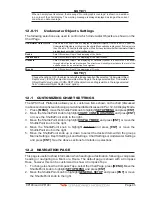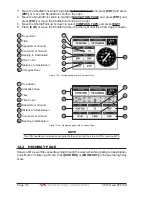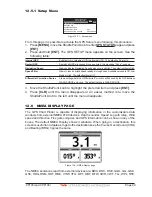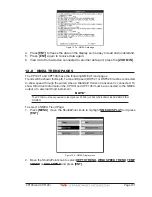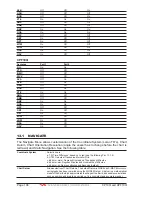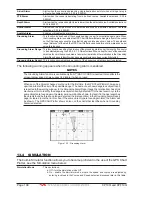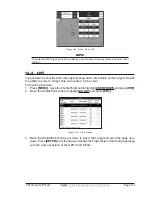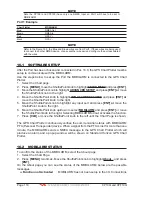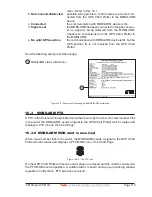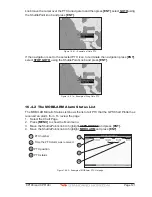
CP190i and CPF190i
Page 107
Chart Orientation Resolution
: Sets the angle the vessel has to change before the chart is redrawn. The default setting
is 30 degrees. Example: if the vessel is heading 000T at a speed of 25 Knots, the display
will redraw:
a. In Home mode the GPS Chart Plotter centers the location of the vessel in the center
of the display. To keep the vessel in the center of the display the GPS Chart Plotter
will occasionally redraw.
b. If the vessel changes course greater than 330T or more than 30T the chart will be
redrawn.
Static Navigation
: Sets up a threshold for the speed. When the speed received from the positioning device
is under that threshold, the GPS Chart Plotter displays zero. The default setting is 0.9 Kts.
13.1.0 Loran TD
The Loran TD selection allows the GPS Chart Plotter to be set up so the user can enter in
LORAN TD’s directly into the GPS Chart Plotter. After the TD’s have been entered, and the
user changes to ddd mm.sss (Degrees Minutes and Seconds) the TD’s will be converted
to Lat / Lon coordinates.
To use the TD Coordinate System the user must setup the Chain and Pair information of
the TD’s. If you do not know this information, refer to paper charts that show the Chain and
Pair information.
ASF1/2
:
Additional Secondary phase Factor (TD Coordinate System)
Correction to TD1/2 values which can be inserted by the user to take in account the
additional signal propagation delay aver a mixed land/seawater path compared to on all-
seawater path. Normally the user does not enter a ASF value. However for experienced
users this function allows entering of signal delay values to fine adjust the calculated
position. The user should enter delay values to fine adjust the position calculated.
Alter
:
Alternate Solution (TD Coordinate System)
Parameter selected by the user that is applied in the conversion of geographical coordinates
Lat/Lon to TD values. To be used if the position displayed is roughly not correct.
13.2 COMPASS
The GPS Chart Plotter computes compass direction from the constellation of GPS
Satellites. For the GPS Chart Plotter to compute direction the vessel must be moving
through the water unless connected to an optional Flux Gate Compass sensor. The
Compass menu allows the GPS Chart Plotter to customize the following selections:
Bearings
: Selects between True and Magnetic. When Magnetic bearings is enabled, the GPS Chart Plotter applies
the selected MagneticVariation (Auto or Manual, see next paragraph) to compute Magnetic bearing.
Variation
: Allows the user to select Auto or Manual. When Auto mode is selected the GPS Chart Plotter computes
the ofset by the curent GPS fixed location. Manual mode allows the user to enter in a magnetic variation
that is applied in the True conversion.
Calibration
: This function allows a user to enter in the offset for areas that the vessel may cruise instead of entering
in a manual offset for one location. This offset is useful for cruising vessels or vessels that travel
internationally often.
Figure 13.2 - Compass Table
13.3 ALARMS
The Alarms menu is used to select and setup audible and visual Alarms. Available alarms
are Arrival, XTE, Depth,Anchor and Grounding Alarm.
Summary of Contents for CP190i
Page 1: ......
Page 5: ...Page 6 CP190i and CPF190i ...
Page 11: ...Page 12 CP190i and CPF190i 21 APPENDIX TERMS 147 ANALYTICALINDEX 151 ...
Page 15: ...Page 16 CP190i and CPF190i ...
Page 49: ...Page 50 CP190i and CPF190i ...
Page 63: ...Page 64 CP190i and CPF190i ...
Page 71: ...Page 72 CP190i and CPF190i ...
Page 83: ...Page 84 CP190i and CPF190i ...
Page 103: ...Page 104 CP190i and CPF190i ...
Page 109: ...Page 110 CP190i and CPF190i ...
Page 137: ...Page 138 CP190i and CPF190i ...
Page 139: ...Page 140 CP190i and CPF190i ...
Page 145: ...Page 146 CP190i and CPF190i ...
Page 149: ...Page 150 CP190i and CPF190i ...
Page 160: ......



